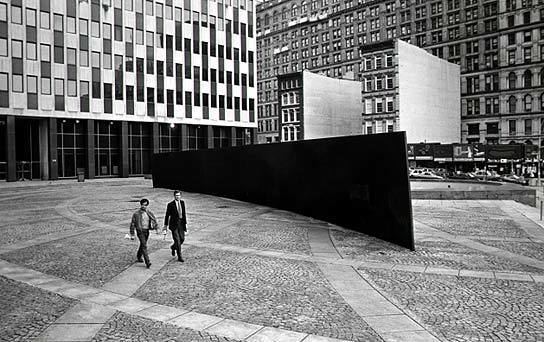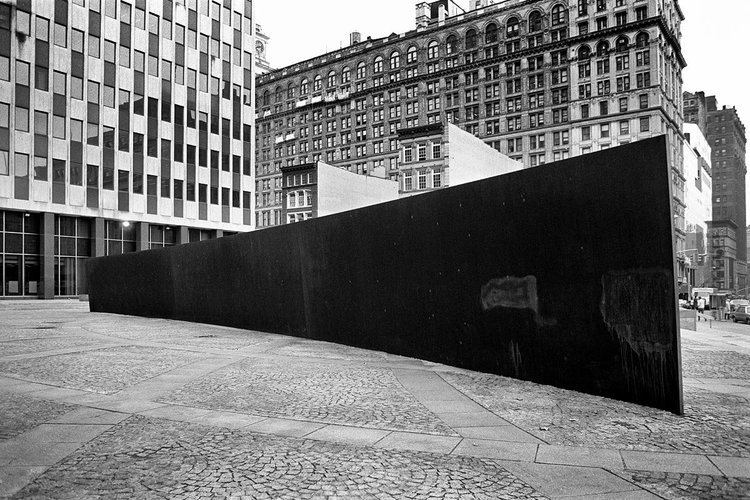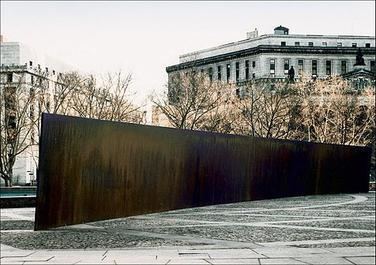Created 1981 | ||
Similar Spiral Jetty, One Ton Prop (House of, Torqued Ellipse IV, The Matter of Time, One and Three Chairs | ||
The trial of tilted arc with richard serra
Tilted Arc was a site-specific sculpture originally commissioned by the United States General Services Administration Arts-in-Architecture program for the Foley Federal Plaza in front of the Jacob K. Javits Federal Building in Manhattan, New York City. The post-minimalist artwork was designed by the well-known artist Richard Serra and constructed in 1981. However, after much debate, it was removed in 1989 following a lawsuit. Richard Serra is one of the leading minimalist sculptors and started his notable body of work after his graduation from Yale University where he studied fine art. This work exemplifies his minimalist, conceptual style. Tilted Arc was created when Serra was forty years old and was already a respected artist; thus, there was much attention given to the removal of his work.
Contents
- The trial of tilted arc with richard serra
- Commissioning and designEdit
- Controversy and trialEdit
- References

Commissioning and designEdit

In 1979 the Art-in-Architecture program decided to commission a work of public art to grace the open space in front of a planned addition to the Javits Federal Building. An outdoor sculpture would be designed for the plaza adjacent to a federal-office complex. Richard Serra was selected as the artist by the U.S. General Services Administration administrator, after having been recommended by a National Endowment for the Arts panel of art experts. Serra was already a notable artist at the time, with much admiration from the art world. The contract for the commission included a release in which Serra gave the work to GSA, making it property of the United States.

Placed in the Federal Plaza, the work bisected the space, blocking views and paths of those who frequented the plaza. The sculpture was a solid, unfinished plate of COR-TEN steel, 120 feet (37 m) long, 12 feet (3.7 m) tall, and 2.5 inches (6.4 cm) thick. As its name suggests, it was slightly tilted. Serra said of the design, "The viewer becomes aware of himself and of his movement through the plaza. As he moves, the sculpture changes. Contraction and expansion of the sculpture result from the viewer's movement. Step by step the perception not only of the sculpture but of the entire environment changes." The steel is self-oxidizing and is designed to develop a natural rust-like amber appearance over time. The work was site-specific. Site-specificity in art means the piece cannot be removed from its location without losing its meaning: the location of a site-specific work is one of its fundamental constituents. In this case, Serra said the sculpture was meant to interact with the commuter passing through the plaza, a location usually passed through quickly on the way to somewhere else.
Controversy and trialEdit

Commissioned in 1979, Tilted Arc immediately attracted intense negative feedback, prominently from Chief Judge Edward D. Re, as well as fierce defenders. Those who worked in the area found the sculpture extremely disruptive to their daily routines, and within months the work had driven over 1300 bureaucratic employees in the greater metro area to sign a petition for its removal. Serra, however, wrote "it is a Site-specific work and as such is not to be relocated. To remove the work is to destroy the work." Designed to be counterintuitive, Tilted Arc effectively redefined the space in which it existed, and due to this intimate relationship between the location and the meaning of the work, Serra's side argued, it could not exist as a piece of humane art unless it remained in that exact location within the Foley Plaza. Therefore, it was claimed that by removing the physical steel sculpture, the government would destroy the broader work, regardless of its physical existence. Because the sculpture forced the site to function as an extension of the sculpture, it was in effect "holding the site hostage." Calvin Tomkins, an art critic for The New Yorker magazine, was quoted saying, "I think it is perfectly legitimate to question whether public spaces and public funds are the right context for work that appeals to so few people – no matter how far it advances the concept of sculpture." The Storefront for Art and Architecture invited prominent NYC artists and architects to envision the future plaza as a protest in "After Tilted Arc".

The trial involving Tilted Arc is cited as the most notorious public sculpture controversy in the history of art law. It was argued in the trial that the work would "run the risk of deflecting explosions into government buildings opposite and impeded adequate surveillance of the area beyond." A public hearing was held on the subject of the sculpture in March 1985, with 122 people testifying in favor of keeping the piece and 58 in favor of removing it. Notable speakers arguing in favor of the sculpture included Philip Glass, Keith Haring, and Claes Oldenburg. Artists, art historians, and even a psychiatrist testified for the sculpture to remain in its location. Local workers argued for removal: one person stated: "Every time I pass this so-called sculpture I just can’t believe it ... The General Services Administration, or whoever approved this, this goes beyond the realm of stupidity. This goes into even worse than insanity. I think an insane person would say, ‘How crazy can you be to pay $175,000 for that rusted metal wall?' You would have to be insane-more than insane." A jury of five voted 4–1 to remove the sculpture. The decision was appealed by Serra, leading to several years of litigation in the courts, but the sculpture was dismantled and placed in storage by federal workers on the night of March 15, 1989.

The next year saw enactment of the Visual Artists Rights Act (VARA). VARA of 1990, an amendment to the Copyright Act of 1976, provides "moral rights" to the artist so that they have rights to attribution and integrity when it comes to paintings, drawings, and sculpture. Tilted Arc was stored in three sections stacked in a government parking lot in Brooklyn upon removal from the plaza. In 1999 they were moved to a storage space in Maryland. It is Serra’s wish that it will never be displayed anywhere other than its original location, therefore, although the work is safe in storage, it will likely never again be erected. Serra states that the case exemplifies the U.S. legal systems preference towards capitalistic property rights over democratic freedom of expression.
William Gaddis satirized these events in his 1994 novel, A Frolic of His Own.
